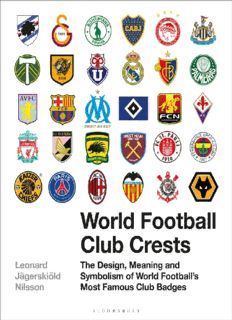
World Football Club Crests: The Design, Meaning and Symbolism of World Football’s Most Famous Club Badges PDF
Preview World Football Club Crests: The Design, Meaning and Symbolism of World Football’s Most Famous Club Badges
CONTENTS INTRODUCTION ENGLAND Arsenal Aston Villa Blackburn Rovers Brighton & Hove Albion Cardiff City Chelsea Crystal Palace Derby County Everton Fulham Hull City Leeds United Leicester City Liverpool Manchester City Manchester United Millwall Newcastle United Queens Park Rangers Sheffield Wednesday Southampton Sunderland Swansea City Tottenham Hotspur West Bromwich Albion West Ham United Wolverhampton Wanderers SPAIN Athletic Bilbao Atlético Madrid Barcelona Deportivo La Coruña Rayo Vallecano Real Betis Real Madrid Real Oviedo Real Sociedad Sevilla Valencia Villarreal ITALY AC Milan Bari Cagliari Calcio Fiorentina Inter Juventus Lazio Palermo Parma Roma Sampdoria Torino GERMANY Bayer Leverkusen Bayern Munich Borussia Dortmund Borussia Mönchengladbach Eintracht Braunschweig Hamburger SV Hertha Berlin 1. FC Köln Schalke 04 FC St. Pauli VfB Stuttgart VfL Wolfsburg FRANCE FC Girondins de Bordeaux FC Lorient AS Monaco FC Nantes Olympique Lyonnais Olympique de Marseille Paris Saint-Germain AS Saint-Étienne Stade de Reims REST OF EUROPE AIK Ajax FC Basel SL Benfica Besiktas Celtic Dynamo Kyiv Fenerbahce Galatasaray Heart of Midlothian Malmö FF Olympiacos FC Porto PSV Eindhoven Rangers Red Bull Salzburg Red Star Belgrade Shakhtar Donetsk Sporting Clube de Portugal Zenit Saint Petersburg USA Chicago Fire Columbus Crew LA Galaxy New York Red Bulls Portland Timbers Seattle Sounders AUSTRALIA Melbourne City Melbourne Victory Perth Glory SOUTH AMERICA Boca Juniors Corinthians Flamengo Fluminense Santos NOTABLE CRESTS ACKNOWLEDGEMENTS ABOUT THE AUTHOR INTRODUCTION Football clubs, their supporters and their society have always fascinated me. What is it that creates their identity, what is it that brings them together and unites them? A club’s identity is expressed in various ways – through the players on the pitch and their attitude, through the colours on the shirts, through the stadium itself and through the fans. But is the club crest the most neglected factor in all this? Is it the crest that connects the fans to the board, the pubs to the dressing room, and the football stars to the autograph-hunters? The emblem is often taken for granted. It’s there on the match programme and the merchandise and nobody really knows what it means and stands for. The club crest is the key symbol for a team, and for its fans and their shared passion, which rests on local bias and tradition: the love of a club is often inherited through generations. And so too is the emblem. It’s no coincidence that the demand to ‘fight for your shield’ or ‘defend the colours’ crop up within football. The club crest is all about identity, history and unity. It unites supporters on the terraces, in beer-soaked pubs, in claustrophobic, packed-out burger bars and in sun-bleached stands. The community can even reach far beyond the boundaries of football, far from the origins of many clubs. For example, the riveting hammers in West Ham’s emblem are symbols of the club’s roots among the iron-workers and dockers in East London. Romulus and Remus, in AS Roma’s club badge, are the twins who, according to mythology, founded Rome and who have always been part of the Italian capital’s collective consciousness. Along with the industrialisation and globalisation of football, the emblem has acquired new values. Today it also represents a brand in a worldwide marketplace. And this is not without its attendant problems. In spite of the historic heritage and symbolic significance, the emblem is constantly modified, for a variety of reasons. Changes in ownership and the desire to fully exploit the brand mean that each season new and modified crests are unveiled around the world. Sometimes these changes reflect the club’s history, and sometimes they don’t. On the latter occasions, the real importance of the club logo is manifested in protests, even revolts, as is true of Hull City AFC: supporter groups have gone to war with the owners in the case of both the club’s name and logo. The emblem is often the source of conflict when the old meets the new, and the interests of the owners often clash with those of the fans. On one hand are the supporters who want to uphold the club’s history, tradition and identity, and on the other are the owners who want to advertise a new start or reach new markets. Such was the case when Paris Saint-Germain was bought by Qatar Sports Investments in 2011. This not only demonstrated that the balance of power in French football had changed but also brought with it a new emblem for PSG. The refashioned crest was meant to demonstrate that the club was now entering a new era. In Wales, Cardiff City’s owner Vincent Tan chose to exchange the blue emblem for a red one in order to establish the club in the Asian market, where red is meant to bring luck. But Tan didn’t stop there. The classic bluebird disappeared from the crest to be replaced by the supposedly more popular Welsh dragon. For several non-European owners – especially of clubs in England but also on the Continent – the value of the global market is accentuated. It’s no coincidence that the pre-season tours have moved to North America and Asia. These are partly new, unexplored markets where the early birds catch the fattest worms. If a modified club emblem can help the owners on the way, the wishes of local supporters tend to be overlooked. A study of club crests is therefore as much to do with learning about the club’s past as understanding its future. That’s also the purpose of this book, to dive into the history of the clubs in order to conjure up an image of the future towards which they – and football in general – are heading. Not an easy process. As I discovered in my journey, the club’s own archives seldom delve very deeply into this
